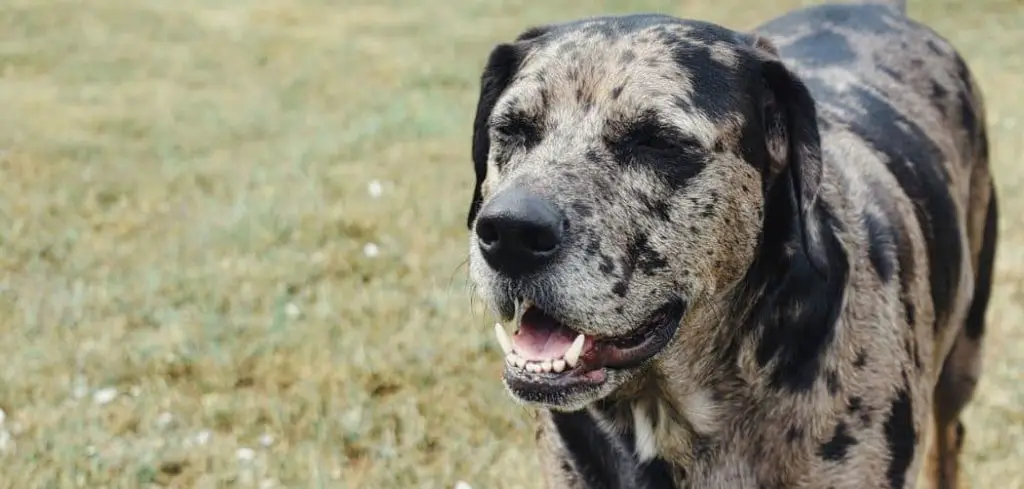If your old dog is drooling and not eating, it can feel especially concerning. Senior dogs are more vulnerable to health complications, and sudden changes in appetite or behavior often indicate underlying illness.
While some age-related changes are normal, excessive drooling and food refusal in older dogs warrant a closer look.
We outline what it means when your old dog starts drooling and not eating, the most common causes behind these symptoms, what you can do at home, and when to involve your veterinarian.
Old Dog Drooling and Not Eating: Why It Happens
When your old dog is drooling and not eating, this concerning symptom combination in senior dogs is often linked to dental disease, nausea, organ dysfunction, oral tumors, or age-related neurological decline.
When an old dog is drooling and not eating, the cause is often complex, and symptoms may develop gradually.
Because older dogs are less resilient to illness and dehydration, it’s important to understand the potential causes and take action quickly.

Old Dog Drooling and Not Eating: Common Causes
Dental Disease and Oral Pain
One of the most common reasons an old dog is drooling and not eating is advanced dental disease.
Years of tartar buildup can lead to gum infections, abscessed teeth, or oral decay—all of which can make chewing extremely painful.
You may notice foul breath, visible tartar, bleeding gums, or even facial swelling.
Older dogs may still try to drink water if it’s not too painful, but they’ll likely avoid food, especially if it’s hard kibble.
Dental care becomes especially critical as dogs age, and neglect can lead to systemic infections affecting the heart and kidneys.
Nausea from Gastrointestinal Issues
Older dogs often develop more sensitive digestive systems.
Conditions like acid reflux, gastritis, or food intolerance can make your senior dog feel nauseated and unwilling to eat.
Nausea also causes drooling, lip licking, and restlessness. You might notice your dog approaching the food bowl but turning away or pacing around uneasily.
If your old dog is drooling and not eating and also appears bloated or tries to vomit without success, this could signal a more serious gastrointestinal condition such as bloat or pancreatitis—both emergencies in older pets.
Related: Dog drooling and not eating (Causes and when to worry)
Kidney or Liver Dysfunction
Senior dogs are more prone to organ dysfunction, especially kidney and liver disease.
These chronic conditions often come with subtle symptoms like weight loss, appetite changes, bad breath, and eventually more visible signs like vomiting and excessive drooling.
If your old dog is drooling and not eating and also seems lethargic, drinks more or less water than usual, or has pale gums, it’s time for bloodwork and a veterinary exam.
Early management of kidney or liver issues can improve comfort and extend your dog’s quality of life.
Oral Tumors or Masses
Unfortunately, oral tumors become more common as dogs age. These masses may develop on the gums, tongue, or roof of the mouth and cause excessive salivation, blood-tinged drool, and pain while eating.
Dogs may attempt to chew but drop food from their mouths or stop eating altogether.
If your senior dog has persistent drooling, visible lumps, or bleeding from the mouth, an oral exam is essential.
Some tumors are benign, while others are cancerous and may require surgery or palliative care.
Neurological Changes or Cognitive Decline
Older dogs can suffer from neurological disorders or canine cognitive dysfunction (similar to dementia). These conditions may affect appetite, coordination, and normal mouth function.
A senior dog may forget mealtimes, become disoriented, or lose interest in eating.
Excessive drooling can also occur if your dog has difficulty swallowing or if nerves affecting facial control are impacted.
While some age-related changes are irreversible, your vet may recommend medication, dietary support, or lifestyle changes to improve comfort.
What to Do if Your Old Dog Is Drooling and Not Eating
When your senior dog suddenly refuses food and starts drooling, here’s what you can do:
Check the mouth gently for broken teeth, swelling, or bleeding.
Offer soft, bland food like boiled chicken and rice to see if appetite returns.
Keep your dog hydrated, offering ice chips or water with low-sodium broth.
Monitor bowel movements and urination, which can hint at internal issues.
Create a calm space with low stress and predictable routines.
Because older dogs are more sensitive to dehydration and nutritional loss, even one missed meal with these symptoms should be taken seriously.
When to Call or Visit Your Vet
Call your vet promptly if:
Your old dog is drooling and not eating for more than 24 hours.
They show additional signs like vomiting, weight loss, or lethargy.
You see visible swelling, bad breath, or bleeding from the mouth.
There are signs of confusion, wobbling, or unsteady walking.
You suspect kidney or liver issues (increased thirst, pale gums, vomiting).
Senior dogs can crash quickly from conditions that younger dogs might tolerate.
Don’t wait for symptoms to resolve on their own—early intervention is key to comfort and longevity.
Related: Puppy drooling and not eating (Causes and what to do)
Key Takeaway
Watching your old dog drooling and not eating can be heartbreaking, especially if it comes on suddenly.
While aging brings natural changes, symptoms like these usually mean something deeper is going on.
Whether it’s dental pain, digestive upset, or something more serious, your prompt response can make a world of difference.
Your senior dog has given you years of love and loyalty—they deserve a thoughtful, gentle approach to any signs of distress. When in doubt, always check in with your veterinarian.
